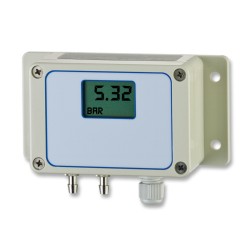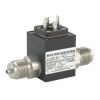 Monitoring and controlling the pressure in a room is a critical parameter in many indoor environments where the climate must be maintained at a particular temperature, humidity and cleanliness/containment level.
Monitoring and controlling the pressure in a room is a critical parameter in many indoor environments where the climate must be maintained at a particular temperature, humidity and cleanliness/containment level.
In hospital operating theatres, semiconductor manufacturing facilities, computer data centers and biochemical research laboratories, it is necessary to ensure either a slightly higher or lower air pressure to prevent a contaminated atmosphere leaking outside or a clean atmosphere becoming contaminated from outside air.
Air pressure is determined by reading the total atmospheric pressure above absolute vacuum which is the same way that meteorological barometric pressure is measured. Although atmospheric pressure is not a constant value, 101325 pascals (Pa) or 1 atmosphere (atm) is widely accepted as the nomimal value to use in calculations for reference purposes.
The variation in air pressure between rooms is actually very small when compared to the total pressure, typically only a fraction of a millibar, much higher pressures would cause problems with opening doors, structural damage and higher energy consumption, so the difference in pressure is always comparatively low.
For example if the pressure difference across two rooms was 1 mbar (100 pascals) that’s equivalent to 100 newtons per square metre. If you assume a door has a size of 1.5 square metre, a 1 mbar difference either side of the door is equivalent to a weight of 15 kg pressing against it.
If the pressure difference is 1 millibar and the ambient pressure is ~1000 mbar, it’s not practical to use a barometer to measure a relatively small pressure difference since the resolution of most barometers would be inadequate to measure the difference precisely.
The most accurate way to measure the difference in air pressure between two rooms is to use a differential pressure (dp) sensor or manometer. A typical dp sensing device incorporates a single measurement diaphragm with pressure connections on both sides isolated from each other. In order to connect the air in each room to the dp device, a pipe is run through a hole between the rooms and connected to one side of the dp sensor. The other pressure connection can be left open to room air pressure.
If the room that the dp sensor is in, is expected to be at a higher pressure, the Positive, +, High or Hi labelled connection port should be left open to room air. If the room that contains the dp sensor is expected to be a lower pressure the Negative, -, Low or Lo labelled connection port should be left open to room air pressure. Not all instruments are calibrated or provide a signal/reading in the negative direction, so a positive configuration of port connections will ensure the most certainty of measurement accuracy.
Related Help Guides
- Measuring vacuum as a negative gauge pressure using a dp sensor
- How do you measure flow rate with a dp cell
- Measuring liquid level in a tank using a dp sensor
- Measuring density of a liquid using a dp sensor
- Measuring negative pressure using a positive differential pressure range
- What can a DP sensor be used to measure beyond differential pressure?
- Measuring flow rate of a liquid or gas using a dp sensor
- Measuring gauge pressure using a dp sensor
- Measuring absolute pressure using a dp sensor
- Measuring barometric pressure using a dp sensor
- Measuring vacuum as an absolute range using a dp sensor
- Measuring liquid level in a sealed tank with a hydrostatic pressure sensor
- What does the suffix a, abs, d, dp and diff, g, rel and sg mean after the pressure units in a pressure range?


